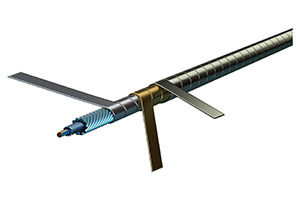Strings are cutting-edge, high-tech products, a combination of physics, mathematics, material science, corrosion science, precision machining, and tool design. Thomastik-Infeld has been researching, developing, building, and producing for over a hundred years. We want to provide you with an insight into our processes and show you the various stages involved in string development.
THE GOAL: AN EXCELLENT VIOLIN STRING
The pitch (440 Hz) and the length of the vibrating string (32.5 cm) are predefined.
-
DEFINE THE STRING TENSION
First, the tension of the string is determined. Thomastik-Infeld strives to make the string tension as low as possible, but as high as necessary. Why? Too little tension in the strings would result in a nasal sound and poor resilience. This means: at a low volume, the string would press too quickly on the fingerboard and vibrate, the string's sound would be affected at higher tension, and so on. Too much tension in the strings would overload the instrument, causing a loss of colors and tonalities, producing a sound similar to that of a trumpet.
The core must also withstand the desired tension of the string. When defining a string tension of 5.50 kg, the core must support at least 5.5 kg of tension without any problem. The string tension defines the necessary mass to tune the string to the correct pitch. Thomastik-Infeld places great importance on safety and reliability. For this reason, an additional safety factor is included so that the string does not break in case of higher tension. This is very similar to a cable car, which should never break, even if the applied tension is higher than usual.
The string tension is the result of the mass per unit length (the mass of the string in the length of the vibrating string). For example: to achieve the string tension with the fictitious value of X, 10 grams per meter are required. In the end, the total mass of all the materials used must be 10 g/m. When selecting the individual materials, this must be carefully considered.
As we can see, there are three specifications: pitch, vibrating string length, and string tension.
-
THE DETAILED DEFINITION OF CHARACTERISTICS THAT A STRING SHOULD HAVE COMES NEXT:
-
Tonal character (brightness and warmth)
-
Tone diversity (rich and complex or pure)
-
Sound when played (wide or focused)
-
Dynamic range: pressure applied by the bow (maximum tension capacity in fortissimo, secure response in pianissimo)
-
Dynamic range: volume and audibility for the performer (in their ear), power and projection for the audience (ppp to fff)
-
Modulation (tolerant or modifiable)
-
Volume modulation (soft or strong)
-
Tone stability
-
Lifespan of winding (resistance to corrosion, abrasion resistance, etc.)
-
Response when changing position in the left hand
-
Bow response
-
Feel in the left hand (soft or firm)
-
Feel in the right hand when bowing (soft or strong)
-
Solution in case of issues like wolf notes, buzzing, or whistling.
-
Taking these characteristics into account, we look for the correct materials, fulfilling the relevant total mass. Then, STRING MANUFACTURING BEGINS.
First, we choose the core material: synthetic (nylon or perlon polyamides, polyester, or a wide range of polyaryletherketone), chromed steel (coated or uncoated), or carbon steel (such as wire or string). The core material supports the string tension, provides the tonal and tactile direction, and has a certain weight (mass per length). For example, synthetics have 1.6–2 g/cm³, while steel has 7.3–7.8 g/cm³.
 |
|
|
|
With the exception of the single string (e.g., the violin E string, the treble strings of a guitar), Thomastik-Infeld strings are made up of several layers. Depending on the desired sound characteristics and functionality, a surface material (the outermost layer material) is chosen. Next, we select the type and number of layers and the material for the inner layers. We decide between round or flat wire and determine how many of them are wound in parallel, that is, simultaneously. |
This naturally leads to limitations and challenges. The higher the density and diameter of the core, the less can be applied to the exterior, so that the mass per unit length exactly matches the specifications.
The more powerful the string needs to sound, the less total mass it must have. M (mass) = (density) x V (volume). The higher the density of a material, the less volume is required to achieve the same mass. For example, silver has a very high density of 10.5 g/cm³. On the other hand, aluminum has a density of 2.6 g/cm³. This means much more aluminum can be used than silver to achieve the same mass.
|
WRAPPING MATERIAL |
DENSITY |
|
|
ALUMINIUM |
2.7 g/cm3 |
Light material |
|
TITANIUM |
4.5 g/cm3 |
Light material |
|
CHROMED STEEL |
7.9 g/cm3 |
Heavy material |
|
NÍCKEL |
8.9 g/cm3 |
Heavy material |
|
SILVER |
10.5 g/cm3 |
Heavy material |
|
GOLD |
19.3 g/cm3 |
Heavy material |
|
TUNGSTEN |
19.3 g/cm3 |
Heavy material |
Naturally, only a very small amount of silver can now be wound around the string. However, this would not provide any mechanical stability, as the string would be extremely thin. A certain thickness must be achieved to ensure the mechanical stability of the winding. This must also be taken into account when selecting winding materials.
The consistency and rigidity of the materials used, as well as their thickness, must also be considered. For example, an E string for violin wound with a tension of 7.7 kg has a carbon steel core with a diameter of 0.22 mm. To achieve this tension, the core is wound with aluminum (2.7 g/cm³) at a thickness of approximately 0.04 mm. If this string were wound with chrome steel (7.9 g/cm³) instead, it would have a thickness of approx. 0.013 mm—only one third. If it were silver, it would actually be only a quarter of the thickness. Chrome steel is a very stable and solid material. For this reason, E strings wound with chrome steel can be manufactured despite the reduced thickness. Silver, on the other hand, is a soft material and would be quickly damaged under stress. As a result, violin E and A strings, as well as viola A strings, are not made with silver winding.
Thomastik-Infeld works with its own high-precision rollers, which are developed and built in-house. These produce filaments with a precision of up to 0.5 microns (0.0005 millimeters). As in sports, these figures make all the difference and put us at the top. After 214 kilometers and about five hours of racing, Marcel Kittel won the 2017 Tour de France by just 0.0003 seconds (at an average speed of 70 km/h, this corresponds to about 6 mm). A fun fact: Thomastik-Infeld was one of the main developers of the Bowden cable for bicycles.
Back to the string: for very high-pitched strings, such as the violin E and A strings and the viola A string, the mass of the core accounts for the predominant part of the total mass. This means that only a very small amount of winding mass can be applied. This is another reason why certain strings—for example, silver violin E and A strings or silver viola A strings—do not exist.
THE FINAL STEP
It takes between 1.5 and 10 minutes to produce a single string, but development can take up to two years. The first prototypes of the strings are tested, improved, and refined until the predefined results are achieved and the string meets our quality standards.






